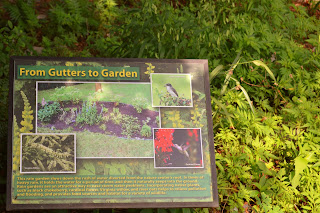Backyard Wildlife Garden at Hemlock Bluffs Nature Preserve
Tucked behind the Stevens Nature Center and just off the service road beside the building, you'll find a perfect example of what you can do in your own backyard to create an oasis for native wildlife like; songbirds, butterflies, hummingbirds, a variety of frogs, toads, lizards and beautiful dragonflies.
 |
| Compact, but creative, the backyard wildlife garden packs a whole lot of habitat into a small space |
Experts agree that it's as simple as including the essential habitat components that all wildlife need into your garden; food, water; cover; shelter and a place to raise young. An easy way to begin in your yard is to focus on attracting songbirds. As seen in the nature center's "backyard", you can place a birdfeeder (keep it clean and filled with seed), a bird box, a birdbath and if your backyard has a little bit of woods - Voila'!, you have habitat for birds!
 |
| Native plants expand the habitat options for small wildlife. Native plants supply important nectar and seeds for local songbirds, hummingbirds and butterflies. They also serve as host plants for butterfly caterpillars. |
Staff at the nature center know to use native NC plants in their gardens (and when and where to plant them). Not only are they essential host plants for NC's butterfly caterpillars, the nectar is essential to native hummingbirds, and the seeds produced are a valuable seed source to songbirds like goldfinches, housefinches and purple finches.
 |
Bushy plants, like Christmas ferns (among others) serve as cover or shelter for small animals
(like lizards, toads and frogs) in the garden. |
Beautifully designed, the nature center's backyard wildlife garden is a place of quiet contemplation. Staff have developed the garden to attract wildlife, but have kept visitors in mind as well. The small gate has a hasp on the top inside, and can be opened to allow access. You are welcome to enter the garden and to sit on the bench to enjoy a moment of reflection and nature study. Hopefully you'll see the animal residents as you enjoy your time in the garden
 |
The plexi-glass viewing window is designed for children visiting the garden.
They can look into the garden without disturbing the inhabitants within.
|
As with all the gardens at the nature center, the backyard wildlife garden is an extension of the environmental education programming of the Stevens Nature Center. It is used extensively as part of the teaching and programming associated with the camps, programs and educational activities offered through the nature center. Stop by and take a look. You may get some ideas to take home to your backyard!


















